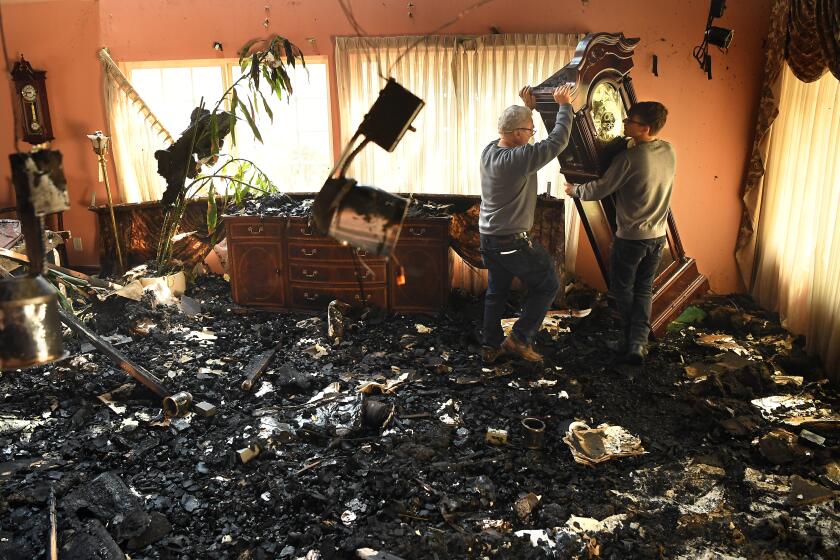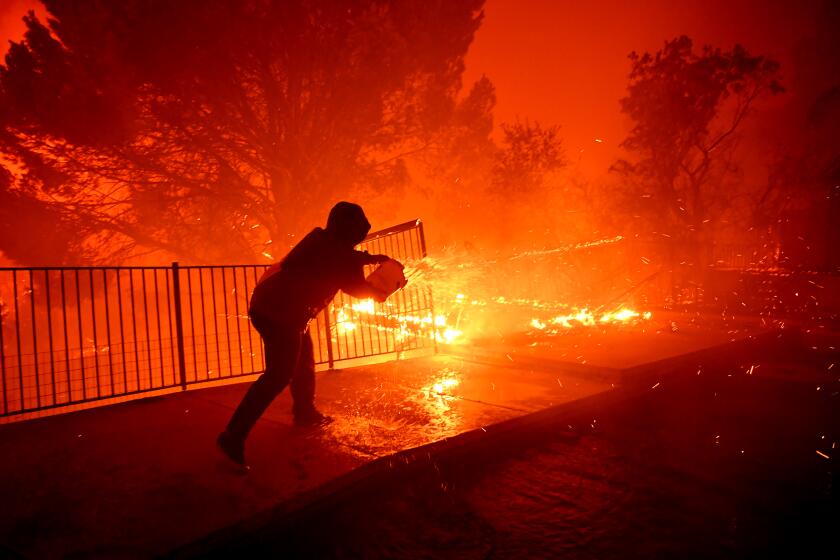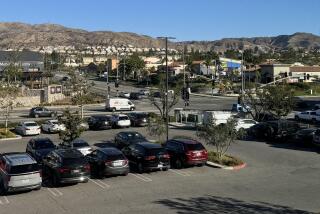LAUSD keeps many Valley schools open during fire, posing a problem for some teachers and parents
- Share via
At Cleveland High School in Reseda on Friday, many teachers weren’t teaching much and their students weren’t learning much as a wildfire raging in the hills spewed choking ash onto campus.
This was not the learning environment that parent Evelyn Alemán had in mind, nor what school district officials had anticipated when they kept scores of San Fernando Valley schools open as the Saddleridge fire raged in the hills above.
The fire emergency led to widespread teacher shortages, mounting school closures throughout the early morning, shelter-in-place orders and early pickups — a tense school day for Valley students and their parents as they navigated road closures, smoky air and, for some, danger.
The wind-driven fire had consumed 7,500 acres, burned at least 31 structures, including homes, and forced thousands of evacuations by late Friday.
Alemán and her daughter, Lucy Macias, were expecting to receive an automated phone alert Friday morning that Cleveland High classes would be canceled. Officials decided to keep the 3,000-student campus open.
By late morning Friday, the Saddleridge fire in the San Fernando Valley had exploded to 4,700 acres and burned 25 homes.
Disasters and unusual events make for difficult logistics in the nation’s second-largest school district. Canceling school means quickly getting out word to everyone from bus drivers to families — and then dealing with those who don’t receive the urgent announcements. Officials also are sensitive to the needs of parents who rely on school for child care so they can work or for their children’s breakfast and lunch.
“Handling these emergency situations is never easy,” said L.A. school board member Kelly Gonez, who represents the East Valley. But more attention needs to be paid to the effects of poor air quality and the hardships of employees, she said.
The Los Angeles Unified School District initially decided to close five campuses in or near the fire zone as officials followed news reports Thursday night. Early Friday, it upped the number to “nearly a dozen,” Chief Steven Zipperman of the L.A. School Police Department said in a statement.
The vast majority of the Valley’s 200-plus schools opened as usual. About three dozen charter schools closed. Four Santa Clarita Valley districts closed all schools. Cal State Northridge, Mission College, Pierce College and College of the Canyons in Valencia also shut down for the day.
The Los Angeles district’s decision to keep as many campuses open as possible posed a major problem for teachers and staffers who could not make it to work because of road and freeway closures.
Although the district had no data immediately available, Friday was probably the biggest day for teachers missing work since the six-day teachers’ strike in January.
The fast-moving Saddleridge fire in the San Fernando Valley has charred dozens of homes, closed freeways and forced thousands to flee.
“Some students … came into our classroom saying, ‘Our teacher isn’t here; can we stay in your class?’” Lucy said. By 8:45 a.m., she had heard multiple intercom announcements about school closures elsewhere, a half-day schedule and air quality concerns. She also watched as some friends made choking noises and said they could taste ash.
“It gave me a little bit of a panic,” said Lucy, who texted her mom to pick her up. She wasn’t the only one. By the time her mother got to school, a line of waiting parents snaked through the hallway outside the office.
Staff, wearing masks, helped to direct traffic.
Some families never made it to school in the first place.
Granada Hills resident Corie Schiffman looked out her window around 2 a.m. Friday and saw burning palm trees. It was time to leave with her husband and two daughters, ages 10 and 7. She decided it would be too dangerous to send them to El Oro Way Elementary School.
Around 6 a.m., they received a call that El Oro would be closed. By then, Schiffman and her family were safely at her mother-in-law’s home in Brentwood.
Annie Wolfstein, who teaches seventh- and eighth-grade math, could not get to Reed Middle School from her home in Canyon Country. She and other cut-off teachers were scrambling to call in lessons while their colleagues tried to cover for them.
Early in the morning, teachers union leaders called on officials to cancel school in the Valley. Union President Alex Caputo-Pearl called it “shameful” that nearly all schools remained open.
“Many other districts, charters and private schools closed,” Caputo-Pearl said. “That the district didn’t reflects a lack of understanding of schools, a disregard for student and employee health, and a willingness to confuse parents.”
The Saddleridge fire ripped through the hills rimming the north edge of the San Fernando Valley, destroying 25 homes, closing freeways and forcing the evacuations of thousands.
About one-third of teachers could not make it to Pacoima Middle School, said Scott Mandel, the school’s musical theater director and the elected union leader for East Valley schools. At Sharp Avenue Elementary in Arleta, two-thirds could not make it to campus, he said.
By 9:48 am, district officials altered course.
“As conditions changed, out of an abundance of caution, we implemented an early-dismissal schedule for all Valley schools and a few schools located in the fire area in Local District West,” Zipperman said.
The situation in schools was sporadically hectic and frequently uncomfortable.
Reed Principal Freddy Ortiz relayed a district directive to keep students inside but also to turn off all air conditioning units “due to the air quality.” L.A. Unified ultimately issued a shelter-in-place alert to keep students inside, an action more commonly associated with gunfire or a dangerous suspect on or near a campus.
Support our journalism
Across the Valley, at Hale Middle School in Woodland Hills, math and science teacher Bruce Newborn reported: “I am smoke-filled, teary-eyed and coughing, but all the kids are safe.”
About a dozen of his students in each class wore masks. And parents were streaming in to pick up students early, which became complicated when the phone system, the pubic address system and the computer system went down, he said.
Newborn lives five minutes from campus, but an office assistant needed 3 ½ hours — instead of 45 minutes — to get from her home in Santa Clarita.
More to Read
Sign up for Essential California
The most important California stories and recommendations in your inbox every morning.
You may occasionally receive promotional content from the Los Angeles Times.













